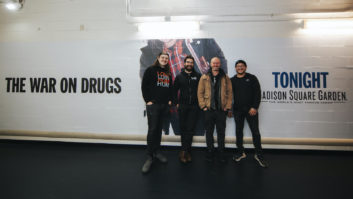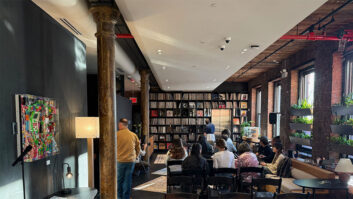
(Note: This column originally appeared in the October issue of Mix.)
I absolutely love flying into New York City in mid-October. Nearly every year since 1989, I’ve done just that, dropping in from the West Coast for the annual AES Show. The thrill never goes away. Whether from SFO to JFK or Oakland to Newark, the five-hour flight always feels a little bit like preparation for the Big Game, like I’m doing mental jumping jacks and hurdler stretches an hour before first pitch in Game 3 of the World Series. By the time I pop out of a cab in Midtown, I’m ready to go!
Forty years after first emerging from Penn Station at the end of a long train ride from Chicago, I still get excited simply by the sheer size and scale and cultural importance of… well, everything! I’m in awe each time I visit, whether I’m walking by the Museum of Natural History, seeing a play on Broadway or simply looking up at endless blocks of 50-story buildings.
READ MORE: Beabadoobee and Rick Rubin on the Epic Journey From Shangri-La to Number One.
One of the problems with living among individuals, institutions and cultural movements that exist on such a large scale, however, is that remarkable things can take place on such an everyday basis that they soon seem normal, that it becomes easy to miss the forest for the trees.
New York has a rich and varied, century-plus history of recording popular music, from the big bands in the 1920s to Broadway cast albums in the ’50s, from Sinatra to Dylan to Springsteen and Beyonce. But 50 years from now, when a future Ken Burns releases a nine-part series on The History of New York Music for PBSstream, the period from the mid-1970s to mid-1980s will be the highlight. That’s when the music industry went through a true seismic shift, and New York City was at the epicenter.
Since the birth of rock and roll, whenever a new “sound” emerges, one influential enough to nudge the direction of popular music, we identify it with a geographical place. The Motown, Muscle Shoals or San Francisco Sound; British Invasion, Southern Rock, Texas Swing, Minneapolis R&B and Seattle Grunge.
In the late 1990s, I interviewed a new San Francisco studio owner for a Mix cover story. He had just cashed out in the first round of tech millionaires and built a three-room, SSL facility just a few blocks from Union Square, with the intention of creating a “new San Francisco Sound.” While the studio was being built, he traveled to Seattle, Minneapolis, Athens, Ga., and Austin, Texas, talking to everyone he could in search of the magic formula. There wasn’t one, he found, but he did tell me that the one thing they all had in common was a vibrant live music scene, one where they all went to each other’s shows and would often move freely in and out of each other’s bands.
Now if we take this admittedly slim theory and apply it to the scale and energy of the music and recording scene in New York City, circa 1975-1985, it becomes so much more than the creation of a new “sound.” It leads to the emergence of a completely new genre of music and spawns an entirely new style of record production.
The explosion of talent and inventiveness that came out of New York at the time was just ridiculous, and it stretched across all genres. Bruce Springsteen released Born to Run in 1975 and Devo appeared on Saturday Night Live in 1978. Donna Summer reigned over disco and later Debbie Harry brought the “Rapture.” Billy Joel and Paul Simon. Nile Rodgers and Chic. David Bowie, Cyndi Lauper, the Ramones, Talking Heads, Laurie Anderson, Lou Reed. Disco and punk began to fade at the same time dance and new wave began to emerge. Rock was going through a period of confusion.
Meanwhile, in the Bronx, hip-hop was quietly becoming a big deal. For the first six years, it remained largely a local phenomenon, featured at block parties and played live with two turntables and a mic. The first hip-hop recording, Rapper’s Delight by Sugar Hill Gang, didn’t come out until 1979. Of course, hip-hop, then mostly called rap, quickly swept the nation and poked its way into the suburbs. In 1986, the Beastie Boys, produced by a young Rick Rubin for his still relatively new label, Def Jam, released the multi-Platinum License to Ill.

That’s Mr. Rubin on this month’s cover of Mix. We’ve tried many times over the past 25 years, and a few weeks ago, he agreed to sit down for an interview with my co-editor, Clive Young. It’s an excellent piece, and while the focus is on his recent work with singer-songwriter Beabadoobee, I can’t help but read between the lines and think back to how those early years in New York, where he was exposed to such a wide range of music and a wide-open spirit of experimentation, helped form his unique approach to production and his massive influence on the music and recording industries over the past 40 years.
Once you’ve finished reading about Rubin, please turn to Lily Moayeri’s feature story on producer Arthur Baker, hailed as one of the pioneers of the 12-inch extended mix in the early ’80s, working with the likes of Afrika Baambaata and New Order and providing a link in the symbiotic relationship between hip-hop and the dance clubs. Tape loops, sampling and the ubiquitous Roland TR-808.
Fall is in the air. Jackets are coming out of the closet. And there’s a pro audio gathering in the Javits Center. It’s a great time to be back in New York City!






